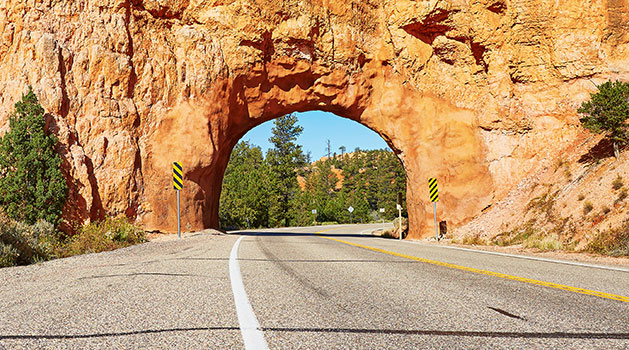It may be just one road, ensconced within just one state, but it encapsulates the entirety of Southwestern splendor.
Found deep in the desert heart of Utah, State Route 12 is also called “A Journey Through Time Scenic Byway” thanks to the towering red rocks, windswept mesas, and geologic color blocking that run along it, laying bare Earth’s long natural history. But seeing everything the road has to offer while on that journey takes some serious time management.
The thoroughfare officially clocks in at just 124 miles, but nearly every inch of it is drenched in natural beauty. All told, the trek traverses through two national parks, three state parks, a national monument, a national recreation area, and a national forest.
Such a dense drive is perfect for anyone looking for a brief history of time—or just looking to enjoy the views—along one of America’s most beautiful highways.
Capitol Reef National Park
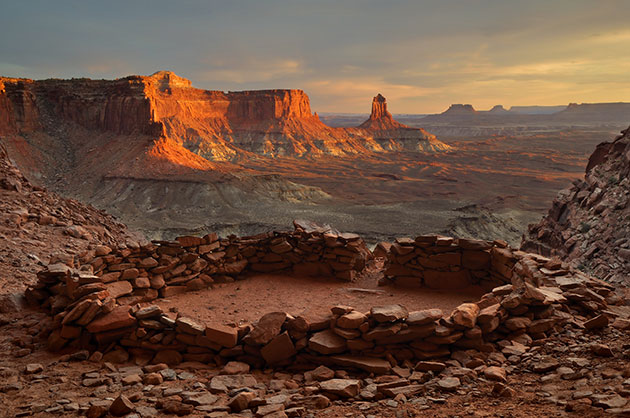
The journey through time begins with a wrinkle in time—and the earth’s crust.
At nearly 100 miles long, the Waterpocket Fold of Capitol Reef National Park marks an epic growth spurt in Earth’s history. The geologic feature first formed 70 million years ago with a tumult of seismic activity, and stretched out once again 50 million years later as the Colorado Plateau rose ever higher and pushed the Rocky Mountains far above the clouds.
The distinctive, striated fold wraps around the whole park—located on the eastern edge of Route 12—but it’s far from the only worthwhile sight. Other natural wonders include the area’s two namesake features: the “capitol” domes of white Navajo Sandstone—so named for their resemblance to the actual government building—and the “reef” of rocky cliff faces, representing a barrier to travel.
Still, brave-hearted souls can indeed explore the regions. Capitol Reef National Park offers extensive hiking and backpacking trails, as well as a number of campgrounds for besotted visitors.
Anasazi Museum State Park
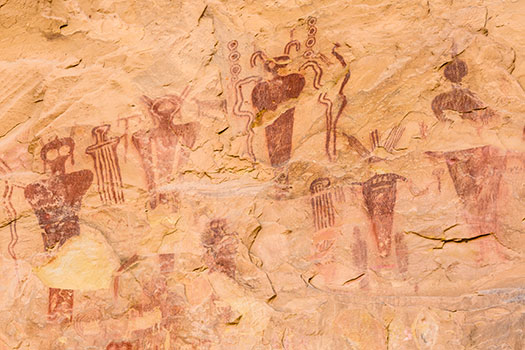
About 40 miles farther west along the route lies a historic expanse offering a unique view into the country’s past: Anasazi State Park, proof that America was always a melting pot.
The park gets its name from the Navajo word for the Ancestral Puebloans, Anasazi, which originally translated to “ancient enemy,” but since been adapted to mean “ancient ones.”
The preservation encapsulates the Coombs Site, the former home of a mixed community where Ancestral Puebloans lived alongside the prehistoric Fremont tribe. In modern times, visitors can still glimpse the foundations of the shared village, including a variety of dwellings, from pit houses to cliffside accommodations.
But that’s not all there is to see—or do—at the park, which also includes a multitude of hiking trails snaking through its gorgeous desert landscape, with access to nearby slot canyons. History buffs can also dive into the area’s roots at the comprehensive Anasazi State Park Museum.
Escalante Petrified Forest
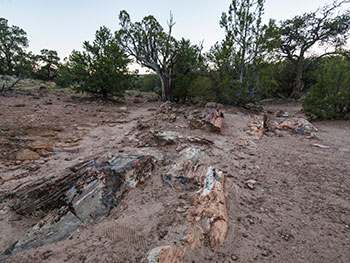
Thirty more miles down the Route 12 trail brings intrepid travelers to the doorstep of Escalante Petrified Forest, but there’s nothing to be scared of in this natural wonderland—unless you decide to make a souvenir of the petrified tree bark, which is rumored to have cursed past visitors (and is also very much illegal).
Guests who love a good theme can also easily parlay the visit with a trip to nearby Spooky Gulch, a narrow slot canyon named for its claustrophobia-inducing width and shadowy scenery.
Creepy qualities aside, the park offers plenty of reasons to visit, including the chance to see dinosaur bones, ancient shell fossils, remnants of the extinct ammonite mollusk, and a forest’s worth of petrified wood.
Hiking enthusiasts can blaze a number of intriguing paths, from the invitingly named Sleeping Rainbows Trail to long walks along ancient lava flows. And water lovers can get their feet wet along the Wide Hollow Reservoir, where visitors can engage in a number of water sports and fishing.
Kodachrome Basin State Park
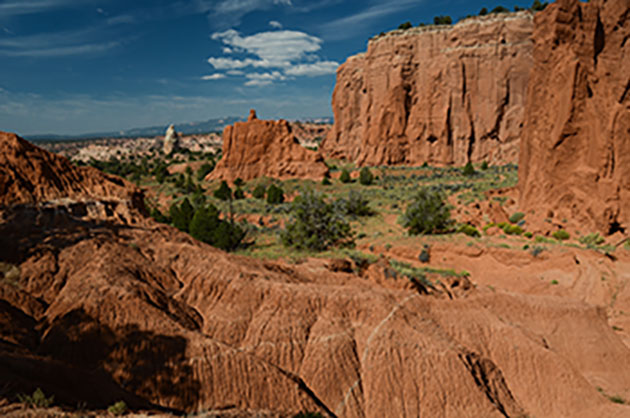
Keep on trucking 32 miles westward to reach the next colorful destination along Route 12, Kodachrome Basin State Park. Named after a suggestion by the National Geographic Society, the moniker is derived from a type of film famous for making bright hues pop right off the photo—and it’s easy to see the inspiration behind their proposal.
The preserve is a study in vibrancy, filled with vivid red rocks and bluebird skies. (The wide-open heavens are just as beautiful at night, offering one of the country’s finest stargazing shows.)
The area’s fascinating topography—composed of skyscraping spires and monolithic rock chimneys spanning 180 million years of geological history—is also quite friendly to a photographer’s eye, and a must-see for any visitor interested in natural beauty. The crown jewel of the expanse is the Grosvenor Arch, one of the most impressive examples of such a formation in all of Utah.
The park can be explored on foot across various hiking trails, by mountain bike, or even via horseback, and visitors who can’t get enough can camp on the grounds.
Bryce Canyon
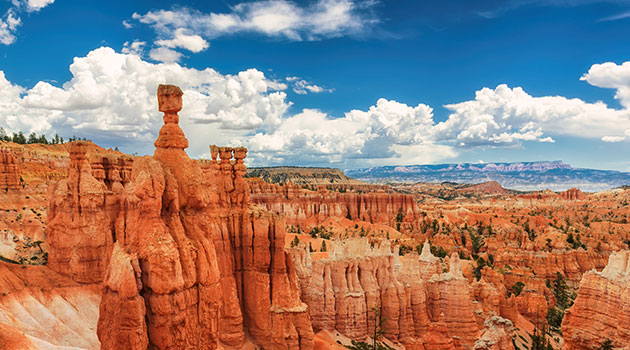
Save enough time on the Journey Through Time to see Bryce Canyon National Park, a truly monumental natural amphitheater that no photograph could do justice to—no matter the type of film being used.
The major attractions of the area are the park’s thousands of hoodoos—which are just as fun to look at as their name is to say. The spindly rock formations are what’s left of a once impressive mesa after millennia of being slowly eaten away by rain and ice, providing a unique and breathtaking linear view through millions of years.
Spanning over 2,000 feet of elevation, the extraordinarily biodiverse park includes a number of different climate zones, each offering its own plethora of plant and wildlife to marvel at.
Hiking trails sprawl throughout the grounds, which are also dotted with campsites. And visitors who choose to stay the night can get the ultimate history lesson: watching the ancient sparkling starlight of the Milky Way gloriously dance across the open desert sky.
Bonus Stops
Utah State Route 12 may offer a "Journey Through Time," but travelers with a few more hours—or days—to kill may be interested in some of the scenic byway’s additional sights.
Boulder Mountain
Boulder Mountain is one of Utah’s premier camping sights. The 11,313-foot peak overlooks Capitol Reef State Park, but this geologic feature is truly deserving of the aquatic name. Aside from its stunning views, the mountain is home to more than 80 lakes and a number of smaller brooks, streams, and other waterways where visitors can swim and fish.
Dixie National Forest
At more than 2 million acres, this expansive national forest has plenty to offer—including the gateway to Boulder Mountain. It boasts four different geographical areas offering a variety of landscapes and wildlife, plus opportunities for camping, hunting, fishing, hiking, and skiing or snowboarding, depending on the season.
Glen Canyon National Recreation Area
A venerable backcountry wonderland, this national expanse spans more than 1.25 million acres, and sprawls all the way to Arizona. Along the way, visitors can treat themselves to any number of gorgeous views and outdoor recreation—including hiking, biking, swimming, kayaking, boating, and smooth water rafting.
